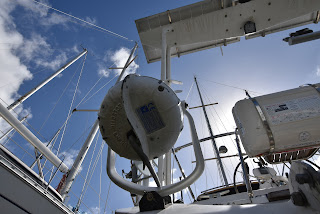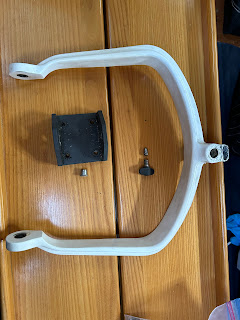In 2024/2025 the Sail-Gen was fully repaired and reassembled with a new cable and I have replaced the damaged mounting bracket with new, so it is fully operational. But.... having pondered this a bit, I will reconsider its location.
When you examine the photo below (the boat as I purchased it) it is easy to see how the Sail-Gen was damaged. The prop has a RH rotation, and it is therefore preferable to dock portside-to, which puts the Sail-Gen in harm's way. (Its injuries were consistent with this sort of impact.) The windvane precludes mounting the sail gen on the centreline, and there are various other compromises to be considered if the sail-gen is to be reolcated. Hmmmm...
Prior Posts
A shout out - again - to the team at Eclectic Energy. Thanks for the great after-sales support.
The sequence of photos below show the repair of the damage to the locking hole. Missing is a photo of the initial weld, prior to grinding/shaping.
The photo below shows how the yoke was secured to the bench and bent back into shape. A light touch is required as the yoke is quite malleable, and is back to its original shape..
How to reduce the risk of damage?
I had assumed the Sail-Gen was damaged by contact with something in the water, however as I worked in the transom area, I realized that the location is quite vulnerable, and that the Sail-Gen was most likely hit or entangled while raised. Because it had been hard-wired, it was permanently hung off the corner of the transom, exposed to both UV degradation and physical damage. The Sail-Gen installation could be improved with some kind of detachable connector system so that it can be moved and stowed to a more protected location when not in use. (which is most of the time) This is contrary to the instructions in the manual, which recommends it be hard-wired and left permanently in place. .
I also note that it is located so far off centre to port, it may only work well on a starboard tack.
Connecting the Sail-Gen
Is there an IEC 309 product available? In the Euro market, the "blue plug" is commonly used for 250VAC. While I could use a cheap, widely available blue plug (male) on the 14VDC sail gen, mating it with a 12VDC flanged receptacle (female) on the transom, that blue outlet on the transom would appear to most to be a 250VAC shore power connection. While the female-female gender-mismatch would most likely prevent an accidental AC shore power connection to the DC system, finding a more foolproof solution by using the correct (or at least different) configuration would be best. Below is a screenshot from
Wikipedia, showing the smaller IEC 60309 connector form factors. The violet one is the corrct configuration. It may only exist in the standards documentation.
As noted by Peter at Eclectic Energy, the 600V 10/2 round boat cable used is built to a CSA/UL standard. (UL1426) Even here in North America, is not widely available. Fortunately, after after some searching, I was able to order some.
June 2024 update
- I have ordered some Sail-Gen repair parts from Eclectic Energy, who were very helpful, responsive and professional. The parts arrived promplty and the communication ws thoughtful and thorough. Thanks Peter and Agnieszka!
I will disassemble the unit when I return to the boat and bring the housing and yoke home for repari/renewal, and will reassemble when I return next time.
Sail-Gen
To the fine folks at Eclectic Energy in the UK, regarding the Sail-Gen:
Sakura was equipped with this rather cool power source when acquired. It was noted in the survey that its 10/2 600v boat cable was too short, and required more slack. I had intended to replace the cable to accomplish this.
However....the unit could not be removed, due to previously unnoticed collision damage that had broken a locking pin, leaving part of the pin trapped in a self-created void worn between two parts, fiendishly preventing their seperation. I did finally get it apart by further damaging a damaged bracket.
At a minimum I need to replace or repair:
- The twisted yoke that holds the unit.
- The transom bracket
- The pin used to secure said yoke into said bracket.
- various nylon bushings, and other normal renewal parts.
- the cable
Will need to know the parts required, and their cost.
Many thanks!
Dave
Hello Dave
Thank you for your message and the photographs.
This combination of D400 and Sail-Gen does work very well. If you are aware of Jimmy Cornell, the sailing author. He fitted this combination to his yacht Aventura 4 with which he completed a transit of the North West Passage.
There maybe nothing wrong with the D400. You may wish to read the manual before unlashing the blades. If the original manuals are missing they can be downloaded from the Eclectic website.
As you point out the yoke and c bracket assembly of the Sail-Gen have suffered damage. It maybe possible to bend the yoke into better alignment as the alloy used is malleable. In this case you would require a new c bracket assembly 90051 170.11 GBP.
If you choose to replace both c bracket and yoke this is part 90008 and the cost is 486.62 GBP
All prices are exclusive of shipping and any duties/taxes which may be payable.
If you wish to proceed, please provide a full delivery address and telephone number and we will provide a proforma invoice.
Note the output cable used for Sail-Gen is of an American manufacture and may not be easy to source. Also, we would not recommend opening the alternator unless there is a compelling reason to do so. This is to maintain the seal formed by the cable gland on the cable and the seal between the two parts of the housing. Given this it would be better to extend the output cable using a waterproof connector or waterproof cable joining system.
I hope the above is helpful.
Best Regards
Peter Anderson
Director
Eclectic Energy Ltd
Tel: +44 1623 835400
Fax: +44 1623 860617
Registered in England: No. 3883495
Registered Office: Unit 22 Sherwood Network Centre,
Sherwood Energy Village, Ollerton, Notts. NG22 9FD, United Kingdom
VAT No: GB 738 1449 18
If you are not the intended recipient, please notify us and delete this e-mail.
www.eclectic-energy.co.uk www.duogen.co.uk
The unit, locked together by a piece of broken pin.
The void worn by the broken pin.
The broken pin itself, the hollow it wore into the bracket, and the broken press-fit threaded collar
The bent yoke. One arm is quite distorted. The unit still pivoted on its yoke.



















No comments:
Post a Comment